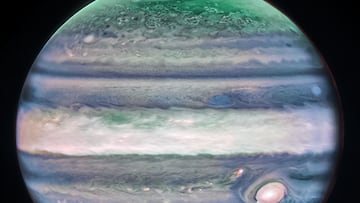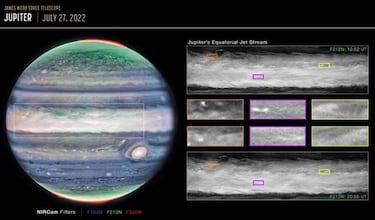What are the ‘jet streams’ captured on the James Webb telescope in the atmosphere of Jupiter?
James Webb Telescope is already helping scientists to better understand weather patterns on Jupiter.

NASA is involved in many space exploration projects, with the Perseverance rover being one of the most notable. The rover has been exploring the surface of Mars for over two years. To support space research, NASA has also developed various telescopes to capture images of the universe. In 2021, the James Webb Space Telescope was launched to replace the Hubble telescope. Unlike any other images captured to date, the first images from James Webb were impressive and revealed a wealth of new space events that were not well understood or unknown to many astronomers.
NASA has made significant progress in space exploration, and recently, it reported a new phenomenon that has never been observed before in Jupiter’s atmosphere. According to a study conducted by Ricardo Hueso from the University of the Basque Country, a high-speed jet stream has been discovered over the planet’s equator. The current is over 4,800 kilometers wide and extends above the primary cloud layers.
Thanks to the precision of the camera, NASA explained that the “James Webb Space Telescope is the only one capable of detecting this type of currents.” Experts acknowledge their surprise at such a discovery because the jet stream was a feature that had always appeared “as blurred hazes in Jupiter’s atmosphere.”

James Webb provides new data
Over the years, various spacecraft such as NASA’s Juno and Cassini, along with the Hubble telescope, have captured Jupiter’s changing weather patterns. However, none of them have been able to provide the same level of detail as the new space telescope. “Webb has already provided new findings on Jupiter’s rings, satellites, and its atmosphere,” added another NASA researcher, Imke de Pater.
Related stories
A newly discovered jet stream, also known as ‘planes’ to astronomers, has been found in Jupiter’s lower stratosphere, about 40 kilometers above the clouds. This jet stream moves at a speed of approximately 515 kilometers per hour, twice the sustained winds of a Category 5 hurricane.
“Jupiter has a complicated but repeatable pattern of winds and temperatures in its equatorial stratosphere, high above the winds in the clouds and hazes measured at these wavelengths,” wrote Leigh Fletcher of the University of Leicester, another member of the team. The new discoveries allow scientists to track the events and formulate new hypotheses to test to gain a deeper understanding of the weather patterns on the planets we share our solar system with.

